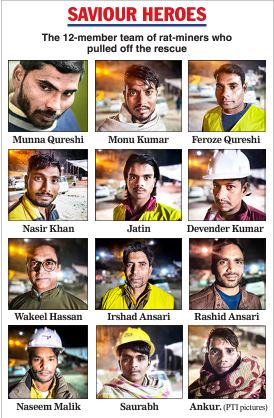Squatting inside a narrow steel pipe of 800mm diameter on their toes, crouching as low as possible with their knees folded and tilted to the left of their body, their hands near their chest and their necks bent as low as possible, rat-hole miners worked relentlessly for close to 24 hours to clear the debris and free the 41 trapped labourers from the Uttarkashi tunnel.
With hardly any room for manoeuvre, the miners entered the steel pipe channel drilled through the debris in sets of two. While the miner in front cleared the rubble, sand, rocks and mass of lattice and mangled steel with the help of a trowel, a handheld drill machine and often with his bare hands, the coworker behind loaded the muck onto a trolley that was then pulled out with a rope by three-four miners standing at the mouth of the pipe. As every inch or so of debris was cleared, rescue workers at the mouth of the passage created by drilling steel Hume pipes one after another through the rubble pushed the channel further and further inside.
The 12 rat-hole miners took turns to work like this inside the pipe from 7.15pm on Monday to 6.30pm on Tuesday to clear the last barrier of 8-10 metres of debris to bring out the workers trapped for 16 days after a stretch of the Silkyara tunnel collapsed following a landslide.

“In the last lap, the trapped labourers saw a portion of the drilling equipment piercing the debris and ran towards it. They also started removing debris from their end in excitement. At that moment I asked my coworker to inform the rescue workers standing at the mouth of the channel to push the pipe further inside to reach the trapped labourers," said Monu Kumar, one of the rat-hole miners who along with Devendra Kumar and Feroze Qureshi were the first to reach the trapped labourers and shake hands with them.
“We can squat on our haunches and rest our body weight on our toes for three hours at a stretch, with our bodies folded as much as possible to adjust to the space where we are working. We can work like this in as little space as two feet, and that is what we did inside the pipe at the Silkyara tunnel to reach the blocked portion. We are called rat-hole miners but even rats cannot stand or sit like this for three hours at a stretch. We held the drill machine right in front of us, vertical to our chest, with the heavier part where its motor is fitted touching the right side of our chest,” Devendra said.
Monu and Devendra hail from Bulandshahr in Uttar Pradesh while Feroze is from Delhi.
They were part of a team of 18 rat-hole miners from two Delhi-based companies who turned out to be the unsung heroes of the rescue operation that swung tantalisingly between hope and despair for 16 days.
“As we three entered the area where the 41 labourers were trapped, they rushed to hug us. They lifted us on their shoulders and offered us almonds and toffees. Then the three of us crawled out of the pipe and the National Disaster Response Force workers brought out the labourers,” Feroze said.
Rat-hole miners are often involved in the construction of narrow tunnels and sewer lines and also clean nallahs before monsoon. They are paid between Rs 300 and Rs 600 per day for a work of 12 hours. They work mostly with companies involved in contractual jobs given out by the public works department and municipal corporations. The majority of the rat-hole miners who were brought to Silkyara said they originally belonged to Jharkhand, Chhattisgarh and west Uttar Pradesh.
Asked how they can work in such difficult circumstances, Surya Mohan, one of the miners who had promised to the media on Monday that they would clear the mountain debris of about 10 metres within 24 hours and save the trapped labourers at any cost, explained: “We can squeeze ourselves and stay in that position for periods longer than any agile and flexible person. We can work in holes with foul smell for two-three hours at a stretch. We can operate in conditions where the oxygen level is low. This is not an expertise, but skills honed through practice since our childhood.”
What do they want in return? “Absolutely nothing,” Surya said.
“Labourers have saved fellow labourers. Maybe someday we will be trapped somewhere during work and these rescued workers will save us,” he said.
“We were not very excited when we were brought from Delhi to Silkyara, but our company wanted us to do the job. Our owner had got a call from the company which is involved in the construction of the (Silkyara Bend-Barkot) tunnel. We entered the tunnel first at 2pm on Monday to inspect the place where we would have to work and told each other that it was not a difficult task for us,” Surya said.
He said he and his fellow miners had never been part of any rescue operation.
Uttarakhand chief minister Pushkar Singh Dhami has announced a reward of Rs 50,000 for each of the rescue workers, including the 18 rat-hole miners. He also handed over cheques of Rs 1 lakh to every rescued labourer at the Chinyalisour community health centre. NDRF and SDRF workers had brought the rescued men to the hospital immediately after they were brought out of the tunnel on Tuesday night.
On Wednesday, the labourers were taken from Chinyalisour to Rishikesh in an IAF helicopter and admitted to AIIMS for extensive physical and mental examinations.
Meenu Singh, the director of AIIMS, Rishikesh, said: “We are checking their blood pressure, pulse and also doing ECG and electrolyte tests. Chest X-rays and psychological assessment will also be done in keeping with the medical protocol. They may suffer from sleep disorder in the coming days but we will provide them with proper advice and medicines.”


